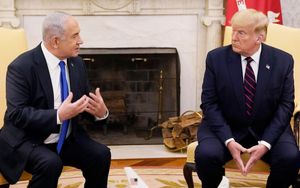Serbia is currently witnessing substantial unrest as students lead mass protests following the recent collapse of a concrete canopy at Novi Sad's main railway station. The tragedy, which resulted in the loss of 15 lives on November 1, 2023, has sparked widespread outrage and galvanized the young populace against what they perceive as rampant government corruption and negligence.
On February 2, 2025, as many as tens of thousands of demonstrators congregated across the River Danube's bridges, marking three months since the incident. Critics contend the canopy collapse was largely due to graft associated with construction contracts tied to Chinese state companies, leading to allegations of substandard work and inadequate safety regulations. The protests—which doubled as blockades—have become emblematic of broader societal discontent with the ruling government, particularly aimed at President Aleksandar Vucic's administration.
University students have emerged at the forefront of this movement, dismantling the complacency once attributed to Serbia's youth. Their energetic call for change resonates through the streets of Novi Sad, where banners proclaiming messages such as "Three months" and "We are defending freedom" wave proudly. Local resident Slavica Nikolic expressed her feelings of optimism, stating, "After long time we can feel positive energy... this is finally some sort of new hope, something good is going to happen." This sentiment exemplifies the frustrations of many who feel disenfranchised under Vucic's leadership.
Driving tractors and waving flags, the demonstrators formed multiple columns as they marched toward the bridge blockades. The anticipation leading to the protests was evident, as clogged access roads bore witness to droves of protesters arriving from Belgrade and other cities. The festive, yet charged atmosphere amplified as people from various walks of life showed support for the students during their lengthy 80-kilometer (50-mile) trek to join the main protests on Saturday.
Vucic, facing mounting pressure from relentless protests, has publicly accused the protesters of being influenced by foreign intelligence aiming to unseat him. While he publicly offers dialogue to the demonstrators, his rhetoric can border on threat, asserting, "The second someone thinks they will use violence to seize power, the state will act like a state, just like everywhere else in the world." This cautious stance indicates the precarious balancing act Vucic is performing, as he attempts to placate increasing civil unrest without appearing weak.
The political turbulence following the canopy collapse has already led to tangible consequences: the resignation of Prime Minister Milos Vucevic earlier this week, indicating the government’s attempt to adapt to the public's outcry. Daily protests have now been reported across Serbia, extending beyond the capital and Novi Sad, manifesting varying degrees of frustration, including violent outbursts from some drivers at protest assemblies.
Student leaders have established themselves as key figures within this mass movement, bringing renewed fervor and dedication to the cause against endemic corruption. Mobilizing resources and galvanizing support from varied sectors, including farmers—who also drove their tractors through the city streets—a community spirit has reignited. The subsequent marshaling of citizens, taxi drivers offering free rides home to marchers, and cyclists joining the protest relay the united front against perceived injustices.
Many Serbians view the canopy collapse controversy as not just about the tragic event itself, but about the overarching failure of public institutions to safeguard their citizens. It has opened the floodgates to inquiries about the quality of public works funded by foreign investment and government contracts, igniting fears about the diminishing rule of law.
The repercussions of the canopy collapse and its aftermath symbolize the frustrations of the Serbian populace. The tide of student-led protests, aptly marked “Three Months — Three Bridges,” serves as both homage to the victims and as rallying points for change. Each gathering and roadblock now echoes the broader discontent, urging traditional leaders—including Vucic—to address the pressing issues endangering public safety and upholding democratic principles.
With tensions still high and protesters demanding substantive reforms, the questions remain: Will the government's recent concessions quell the unrest or merely serve as temporary fixes to systemic issues? And as the movement continues to draw participants from diverse backgrounds, will the protest's momentum carry beyond this momentous time, reshaping Serbia's political future?



